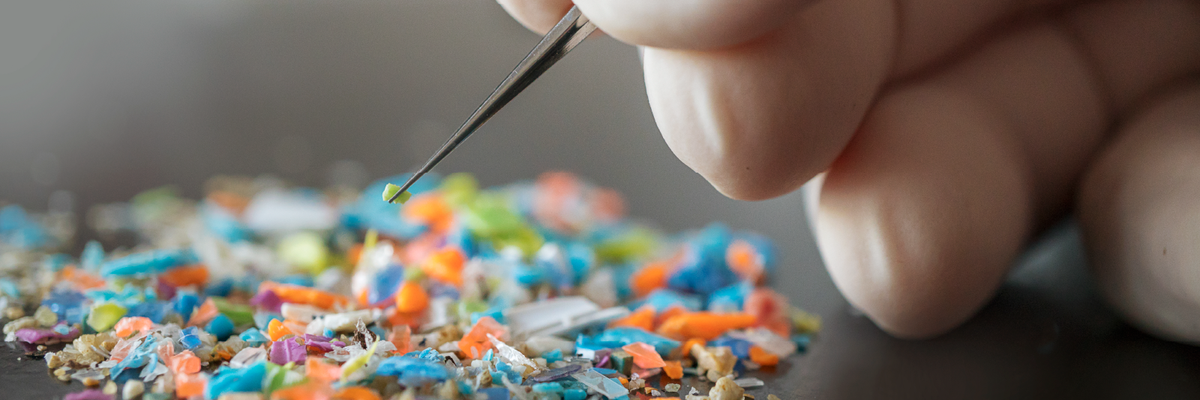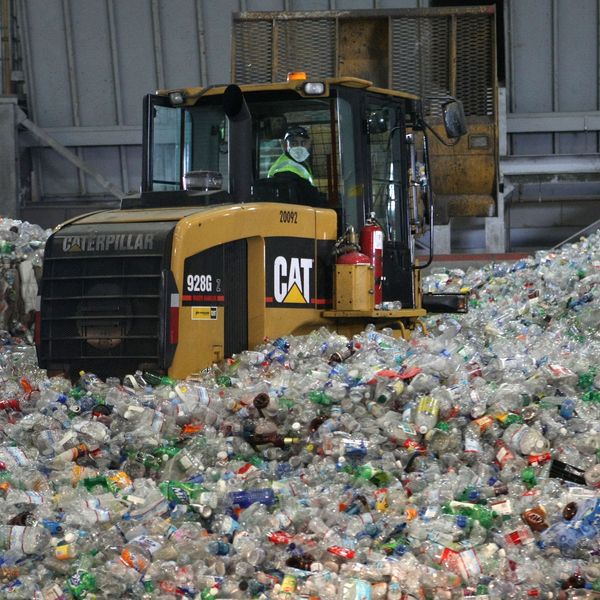
A picture of microplastics is displayed on an FDA web page.
Why Is the FDA Downplaying the Risk of Microplastics From Food Packaging?
The agency charged with keeping our food safe doesn’t think microplastics in food are a big deal, and claims they are probably coming from the food rather than the plastic it’s packaged in.
The Food and Drug Administration has entered the plastic pollution fray. This summer the agency published a web page ostensibly meant to calm consumers’ nerves about the recent spate of reporting on microplastic contamination. Despite the FDA’s clout, the publication relies on hand-waving and empty reassurances, which do nothing to instill trust in the agency charged with keeping our food supply safe.
Microplastics seem to be on the tip of everyone’s tongue these days. Sadly, tongues aren’t the only place researchers find microplastics in our bodies. The minuscule plastic particles have now been found in our blood, testes, and placentas. This came after researchers first established microplastics are present in every place they’ve looked, from the soil to Mount Everest. What’s next, tiny plastic particles passing through our blood-brain barriers?
It’s worth taking stock of how we got to this point of such widespread contamination. Every single thing made of plastic eventually breaks down. This happens due to environmental conditions such as friction, heat, and exposure to light. In the process, tiny plastic particles enter the environment and then degrade into smaller and smaller particles, with no end to the process. Plastic objects become microplastics, which eventually become nanoplastics. Each degradation stage makes it easier for the contaminants to enter our bodies, where they may release the chemicals used to make them. Nearly all plastic is made from oil and gas and then processed with myriad other chemicals—many dangerous toxicants or undisclosed. Research and testing have shown that some chemical additives and processing aids are likely leaching out of plastic food packaging.
Currently, the FDA should be using its full regulatory authority to combat the crisis of microplastics and nanoplastics in our food supply.
Plastic is a ubiquitous food packaging material, so it would seem logical to think that plastic packaging releases microplastics into the foods and beverages packaged within and into the outside environment. And some researchers have documented just that. However, the FDA makes the astounding claim that the microplastics and nanoplastics found in food are most likely from “environmental contamination where foods are grown or raised,” but not from food packaging. The agency claims to make this leap from logic due to insufficient evidence that microplastics and nanoplastics are migrating from plastic food packaging into food. Yet, evidence is beginning to surface, so why is the FDA confusing consumers about microplastics? Researchers tested bottled water for microplastics and found that their data shows contamination is likely coming in part “from the packaging and/or bottling process.” Others found a relationship between plastic bottle density and the pH of packaged mineral water with the amount of microplastic contamination found in the packaged waters.
Discounting plastic food packaging as a source of microplastic contamination is a stretch when we know that everything made of plastic degrades. It’s far more likely that the microplastics found in food came from various sources, including packaging, the food itself, the soil in which it was grown, and food processing equipment. The bigger remaining question is precisely what contamination is doing to our bodies. Researchers are beginning to scratch the surface of that question, and the results are problematic. Recent publications show that breathing microplastics into our lungs may be affecting respiratory systems, and microplastics that cross the blood-brain barrier could impact our behavior. We can expect many more headlines about microplastics and our health in the next few years.
By sounding so certain that food packaging is not a source of microplastics and nanoplastics, the FDA may be misleading and confusing consumers just because the number of studies showing evidence of microplastic migration is thin. A lack of evidence due to the developing nature of this research does not assure us there is no evidence waiting to be found. Unfortunately, this see-no-evil approach is precisely how chemical management happens in the U.S.; new chemicals are created and sold without safety testing.
We are witnessing the early stages of a widespread contamination moment, where communities begin to recognize what is happening, and decision-makers are expected to address concerns meaningfully. Currently, the FDA should be using its full regulatory authority to combat the crisis of microplastics and nanoplastics in our food supply. This problem will get bigger before it gets better due to the massive volume of plastics already in the world and because plastic is currently being made in greater and greater quantities. All the more reason for us to turn off the petrochemical plastics tap as much as we can, for instance, by stemming the widespread manufacture and use of single-use plastics that we lived without just a decade or two ago.
An Urgent Message From Our Co-Founder
Dear Common Dreams reader, The U.S. is on a fast track to authoritarianism like nothing I've ever seen. Meanwhile, corporate news outlets are utterly capitulating to Trump, twisting their coverage to avoid drawing his ire while lining up to stuff cash in his pockets. That's why I believe that Common Dreams is doing the best and most consequential reporting that we've ever done. Our small but mighty team is a progressive reporting powerhouse, covering the news every day that the corporate media never will. Our mission has always been simple: To inform. To inspire. And to ignite change for the common good. Now here's the key piece that I want all our readers to understand: None of this would be possible without your financial support. That's not just some fundraising cliche. It's the absolute and literal truth. We don't accept corporate advertising and never will. We don't have a paywall because we don't think people should be blocked from critical news based on their ability to pay. Everything we do is funded by the donations of readers like you. Will you donate now to help power the nonprofit, independent reporting of Common Dreams? Thank you for being a vital member of our community. Together, we can keep independent journalism alive when it’s needed most. - Craig Brown, Co-founder |
The Food and Drug Administration has entered the plastic pollution fray. This summer the agency published a web page ostensibly meant to calm consumers’ nerves about the recent spate of reporting on microplastic contamination. Despite the FDA’s clout, the publication relies on hand-waving and empty reassurances, which do nothing to instill trust in the agency charged with keeping our food supply safe.
Microplastics seem to be on the tip of everyone’s tongue these days. Sadly, tongues aren’t the only place researchers find microplastics in our bodies. The minuscule plastic particles have now been found in our blood, testes, and placentas. This came after researchers first established microplastics are present in every place they’ve looked, from the soil to Mount Everest. What’s next, tiny plastic particles passing through our blood-brain barriers?
It’s worth taking stock of how we got to this point of such widespread contamination. Every single thing made of plastic eventually breaks down. This happens due to environmental conditions such as friction, heat, and exposure to light. In the process, tiny plastic particles enter the environment and then degrade into smaller and smaller particles, with no end to the process. Plastic objects become microplastics, which eventually become nanoplastics. Each degradation stage makes it easier for the contaminants to enter our bodies, where they may release the chemicals used to make them. Nearly all plastic is made from oil and gas and then processed with myriad other chemicals—many dangerous toxicants or undisclosed. Research and testing have shown that some chemical additives and processing aids are likely leaching out of plastic food packaging.
Currently, the FDA should be using its full regulatory authority to combat the crisis of microplastics and nanoplastics in our food supply.
Plastic is a ubiquitous food packaging material, so it would seem logical to think that plastic packaging releases microplastics into the foods and beverages packaged within and into the outside environment. And some researchers have documented just that. However, the FDA makes the astounding claim that the microplastics and nanoplastics found in food are most likely from “environmental contamination where foods are grown or raised,” but not from food packaging. The agency claims to make this leap from logic due to insufficient evidence that microplastics and nanoplastics are migrating from plastic food packaging into food. Yet, evidence is beginning to surface, so why is the FDA confusing consumers about microplastics? Researchers tested bottled water for microplastics and found that their data shows contamination is likely coming in part “from the packaging and/or bottling process.” Others found a relationship between plastic bottle density and the pH of packaged mineral water with the amount of microplastic contamination found in the packaged waters.
Discounting plastic food packaging as a source of microplastic contamination is a stretch when we know that everything made of plastic degrades. It’s far more likely that the microplastics found in food came from various sources, including packaging, the food itself, the soil in which it was grown, and food processing equipment. The bigger remaining question is precisely what contamination is doing to our bodies. Researchers are beginning to scratch the surface of that question, and the results are problematic. Recent publications show that breathing microplastics into our lungs may be affecting respiratory systems, and microplastics that cross the blood-brain barrier could impact our behavior. We can expect many more headlines about microplastics and our health in the next few years.
By sounding so certain that food packaging is not a source of microplastics and nanoplastics, the FDA may be misleading and confusing consumers just because the number of studies showing evidence of microplastic migration is thin. A lack of evidence due to the developing nature of this research does not assure us there is no evidence waiting to be found. Unfortunately, this see-no-evil approach is precisely how chemical management happens in the U.S.; new chemicals are created and sold without safety testing.
We are witnessing the early stages of a widespread contamination moment, where communities begin to recognize what is happening, and decision-makers are expected to address concerns meaningfully. Currently, the FDA should be using its full regulatory authority to combat the crisis of microplastics and nanoplastics in our food supply. This problem will get bigger before it gets better due to the massive volume of plastics already in the world and because plastic is currently being made in greater and greater quantities. All the more reason for us to turn off the petrochemical plastics tap as much as we can, for instance, by stemming the widespread manufacture and use of single-use plastics that we lived without just a decade or two ago.
The Food and Drug Administration has entered the plastic pollution fray. This summer the agency published a web page ostensibly meant to calm consumers’ nerves about the recent spate of reporting on microplastic contamination. Despite the FDA’s clout, the publication relies on hand-waving and empty reassurances, which do nothing to instill trust in the agency charged with keeping our food supply safe.
Microplastics seem to be on the tip of everyone’s tongue these days. Sadly, tongues aren’t the only place researchers find microplastics in our bodies. The minuscule plastic particles have now been found in our blood, testes, and placentas. This came after researchers first established microplastics are present in every place they’ve looked, from the soil to Mount Everest. What’s next, tiny plastic particles passing through our blood-brain barriers?
It’s worth taking stock of how we got to this point of such widespread contamination. Every single thing made of plastic eventually breaks down. This happens due to environmental conditions such as friction, heat, and exposure to light. In the process, tiny plastic particles enter the environment and then degrade into smaller and smaller particles, with no end to the process. Plastic objects become microplastics, which eventually become nanoplastics. Each degradation stage makes it easier for the contaminants to enter our bodies, where they may release the chemicals used to make them. Nearly all plastic is made from oil and gas and then processed with myriad other chemicals—many dangerous toxicants or undisclosed. Research and testing have shown that some chemical additives and processing aids are likely leaching out of plastic food packaging.
Currently, the FDA should be using its full regulatory authority to combat the crisis of microplastics and nanoplastics in our food supply.
Plastic is a ubiquitous food packaging material, so it would seem logical to think that plastic packaging releases microplastics into the foods and beverages packaged within and into the outside environment. And some researchers have documented just that. However, the FDA makes the astounding claim that the microplastics and nanoplastics found in food are most likely from “environmental contamination where foods are grown or raised,” but not from food packaging. The agency claims to make this leap from logic due to insufficient evidence that microplastics and nanoplastics are migrating from plastic food packaging into food. Yet, evidence is beginning to surface, so why is the FDA confusing consumers about microplastics? Researchers tested bottled water for microplastics and found that their data shows contamination is likely coming in part “from the packaging and/or bottling process.” Others found a relationship between plastic bottle density and the pH of packaged mineral water with the amount of microplastic contamination found in the packaged waters.
Discounting plastic food packaging as a source of microplastic contamination is a stretch when we know that everything made of plastic degrades. It’s far more likely that the microplastics found in food came from various sources, including packaging, the food itself, the soil in which it was grown, and food processing equipment. The bigger remaining question is precisely what contamination is doing to our bodies. Researchers are beginning to scratch the surface of that question, and the results are problematic. Recent publications show that breathing microplastics into our lungs may be affecting respiratory systems, and microplastics that cross the blood-brain barrier could impact our behavior. We can expect many more headlines about microplastics and our health in the next few years.
By sounding so certain that food packaging is not a source of microplastics and nanoplastics, the FDA may be misleading and confusing consumers just because the number of studies showing evidence of microplastic migration is thin. A lack of evidence due to the developing nature of this research does not assure us there is no evidence waiting to be found. Unfortunately, this see-no-evil approach is precisely how chemical management happens in the U.S.; new chemicals are created and sold without safety testing.
We are witnessing the early stages of a widespread contamination moment, where communities begin to recognize what is happening, and decision-makers are expected to address concerns meaningfully. Currently, the FDA should be using its full regulatory authority to combat the crisis of microplastics and nanoplastics in our food supply. This problem will get bigger before it gets better due to the massive volume of plastics already in the world and because plastic is currently being made in greater and greater quantities. All the more reason for us to turn off the petrochemical plastics tap as much as we can, for instance, by stemming the widespread manufacture and use of single-use plastics that we lived without just a decade or two ago.

